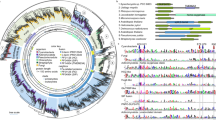Abstract
THE red pigment in the root nodules of a leguminous plant (Vicia Faba) was investigated for the first time by Pietz1. He believed it to be identical with the red intermediate product which appears during the oxidation of tyrosine or of dihydroxyphenylalanine ('dopa') catalysed by tyro-sinase. According to Pietz., the red pigment, by undergoing a reversible reduction, has the function of poising the oxido-reduction potential of the nodule at a level favourable for the proliferation of symbiotic bacteria inhabiting the nodule.
This is a preview of subscription content, access via your institution
Access options
Subscribe to this journal
Receive 51 print issues and online access
$199.00 per year
only $3.90 per issue
Buy this article
- Purchase on Springer Link
- Instant access to full article PDF
Prices may be subject to local taxes which are calculated during checkout
Similar content being viewed by others
References
Pietz, J., Z. Bakt., (2), 99, 1 (1938).
Kubo, H., Acta Phytochim., 11, 195 (1939).
Burris, R. M., and Haas, E., J. Biol. Chem., 155, 227 (1944).
Wilson, P. W., Ergeb. Enzymfor., 8, 13 (1939).
Wilson, P. W., "The Biochemistry of Symbiotic Nitrogen, Fixation" (Madison: The University of Wisconsin Press, 1940).
Author information
Authors and Affiliations
Rights and permissions
About this article
Cite this article
KEILIN, D., WANG, Y. HæMoglobin in the Root Nodules of Leguminous Plants. Nature 155, 227–229 (1945). https://doi.org/10.1038/155227a0
Issue Date:
DOI: https://doi.org/10.1038/155227a0
This article is cited by
-
Effect of seed treatment ofArachis hypogaea withBacillus subtilis on nodulation in biocontrol of southern blight (Sclerotium rolfsii) disease
Phytoparasitica (2007)
-
A cereal haemoglobin gene is expressed in seed and root tissues under anaerobic conditions
Plant Molecular Biology (1994)
-
The effect of inositol on the growth and nodulation of diploid and tetraploid white clover grown in pot culture
Plant and Soil (1964)
-
Incorporation of Amino-Acid by Root Nodules of Galega Officinalis
Nature (1963)
-
Oxygenation of Leghæmoglobin in Soybean Root-Nodules in Relation to the External Oxygen Tension
Nature (1962)
Comments
By submitting a comment you agree to abide by our Terms and Community Guidelines. If you find something abusive or that does not comply with our terms or guidelines please flag it as inappropriate.



